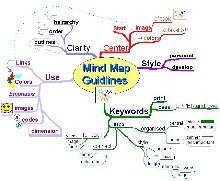
Mind Mapping: Preparing to be Brain-Ready...
By BrainReady.com special guest contributor Dr. Stephen Lundin, Ph.D
Readers of BrainReady.com are well aware of the benefits of a brain-healthy lifestyle. And many of you, like me, are particularly interested in making sure your memory functions as well as it can, now and as you get older. As you read this article, try to adopt a different perspective on your memory: rather than focusing on "getting things out of your memory banks", I'd like you to consider how you put things into your memory banks in the first place.
The way in which we learn affects how much and how long we remember what we have learned. Lets take a moment to review what we know about the brain as it relates to learning and memory:
- The brain remembers things by the associations formed between those things. The more associations that are formed, the more likely you will be able to recall a particular element later. Yes, even if some of the associations are weakened as a part of age-related cognitive decline.
- The associations can be with words, colors, images, smells, tastes, sounds, textures and emotions. This is called synesthesia (which we discussed in a previous BrainReady Blog article).
- The brain operates in a radiant rather than a linear manner. Much of learning is delivered in a linear (and boring, to the mind) format that contains few of the elements necessary for optimal recall.
Fortunately, there is a technique that operates in a manner consistent with the way the brain functions. It is called Mind Mapping, and it is the creation of Tony Buzan, a British writer and psychologist who has published dozens of books on the subject. Tony is also a friend of mine who wrote the forward to my most recent book, CATS: The Nine Lives of Innovation (published by Management Press in Australia in 2007 and scheduled to be published by McGraw Hill in the rest of the world in January of 2009. Check my blog at for updates.)
Mind Mapping, briefly summarized, is a radiant display of words, colors and images that has a central image, with lines radiating from the central image. The lines represent the associations and as the lines radiate out from the center, key words, color and images build a structure that conveys the meaning with about 3% of the words it would take if you were using standard linear text. A Mind Map is designed to be remembered effectively because it presents information in a far more brain-friendly manner. It can put all the information necessary for a full understanding of a subject on one page, and in a much more engaging format than linear text could provide.

Mind Maps can be used to organize everything from the content of a book to concepts, meeting notes, your observations about a subject, the possibilities are almost endless. It can also be used as part of the creative process as a way to prepare to write, consider strategy or organize a speech.
In a moment I will direct you to a couple of web sites where you can look at a variety of mind maps, but first I will take you through a Mind Mapping process that I use all the time in my work.
In my public speaking work, I like to speak without notes or PowerPoint decks, and in order to do that I prepare with a Mind Map. The subject of my talk takes the form of a central image; recently this has been a fish, a top hat or a cat, given the metaphors used in my recent books. Then from the central image I draw lines that are exactly the same length as the word I place on that line. These key words close to the central image represent the key themes of the talk.
Then, branching from these key words are other lines, images or quotes that trigger things I want to be sure to cover. I then use different colors for the lines and words of different branches. I study this Mind Map on one or two occasions before giving the talk. During my talk I take the Mind Map in my pocket for security (I am human), but it always stays in my pocket. I find that I can “see” the Mind Map as I speak, and that's because it is so memorable. Far more than a slide deck or linear sheet of notes could be.
Another great use of a Mind Map is to take notes during a fluid meeting. A Mind Map provides the flexibility needed if the subject moves around, as often happens in meetings. No matter how disorganized the discussion, the Mind Map is always organized.
The Mind Mapping technique and topic go much deeper, so I encourage you to learn more about it, particularly as it's a skill you can use for the rest of your life. It's simple. If you want to remember, organize your thoughts in Mind Map form.
Now, check out Tony Buzan in a six-minute presentation:
http://www.youtube.com/watch?v=MlabrWv25qQ
Tony Buzan’s main web site:
http://www.buzanworld.com/
A mind map of an accounting class:
http://mappio.com/mindmap/info-ideamappingsuccess-com/accounting-501
(Big thanks to best-selling business author, speaker and educator Dr. Lundin for yet another original BrainReady Blog article, and be sure to check out his own personal blog at: http://bigtuna.typepad.com)




